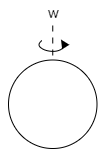Question
Question: A player strikes a football such that it started spinning in the air with an angular velocity \(\ome...
A player strikes a football such that it started spinning in the air with an angular velocity ω as shown in the diagram. Another player of an opposite team punctures the football through a sharp needle in the air such that the radius of the football contract to 75% of its original value. What will be the new angular velocity of the football if the weight of the football remains the same?

(A) 74ω
(B) 916ω
(C) 254ω
(D) 425ω
Solution
The solution can be determined by equation the torque of the football before puncher with the torque of the football after puncher. The torque is given by the product of the moment of inertia and the angular velocity. By using this equation, the new angular velocity can be determined.
Useful formula
The torque of the football is given by,
T=I×ω
Where, T is the torque of the ball, I is the moment of inertia and ω is the angular velocity.
The moment of inertia for spherical ball is,
I=32mR2
Where, I is the moment of inertia, m is the moment of inertia and R is the radius of the sphere.
Complete step by step solution
Given that,
The initial radius is R1
The final radius is, R2=75%×R1⇒10075R1⇒43R1
Now,
The torque of the football is given by,
⇒T=I×ω
From the above equation, the torque for the football before puncher is given by,
⇒T=I1×ω1
The torque for the football after puncher is given by,
⇒T=I2×ω2
By equating the two torque equations, then
⇒I1×ω1=I2×ω2
By substituting the moment of inertia values on both sides, then the above equation is written as,
⇒32mR12×ω1=32mR22×ω2
By cancelling the same terms, then
⇒R12×ω1=R22×ω2
By keeping the term ω2 in one side, then
⇒ω2=(R2R1)2×ω1
By substituting the value of R2, then
⇒ω2=43R1R12×ω1
By cancelling the same terms, then
⇒ω2=4312×ω1
By rearranging the terms, then
⇒ω2=(34)2×ω1
By squaring the terms, then
⇒ω2=916ω1
Hence, the option (B) is the correct answer.
Note: From the final answer, it shows that the angular velocity of the football before puncher is less than the angular velocity of the football after puncher. The angular velocity is increasing that the radius of the object is decreasing. If the radius increases the angular velocity decreases.
